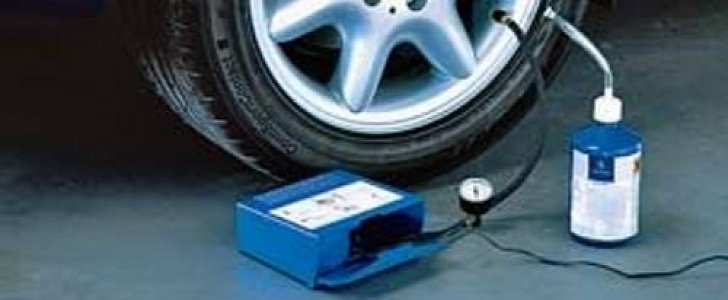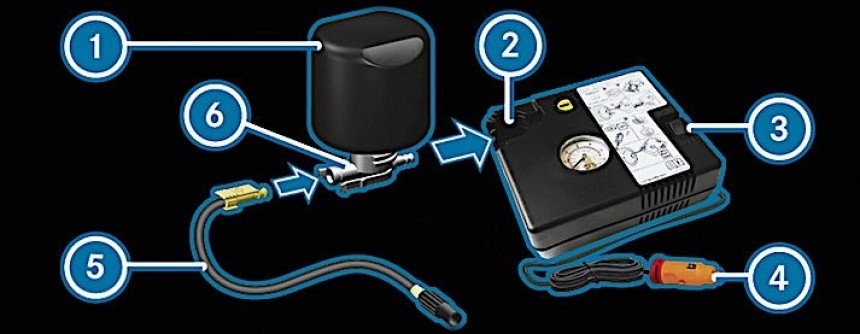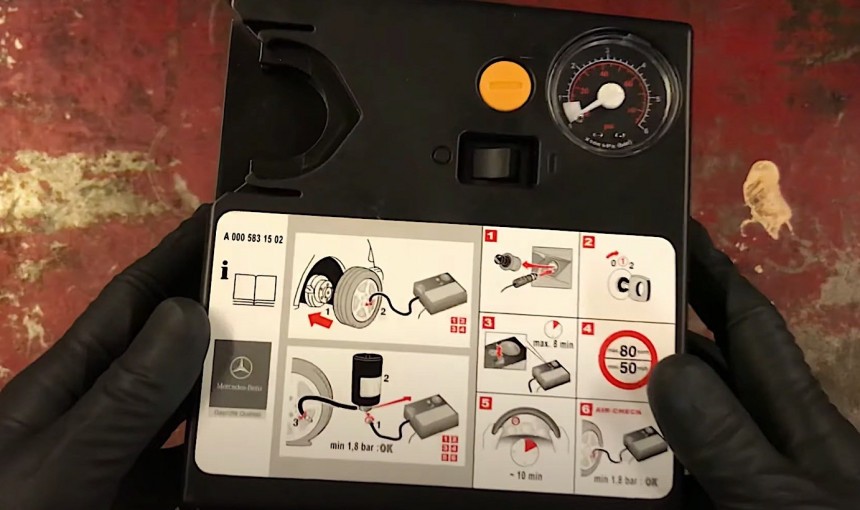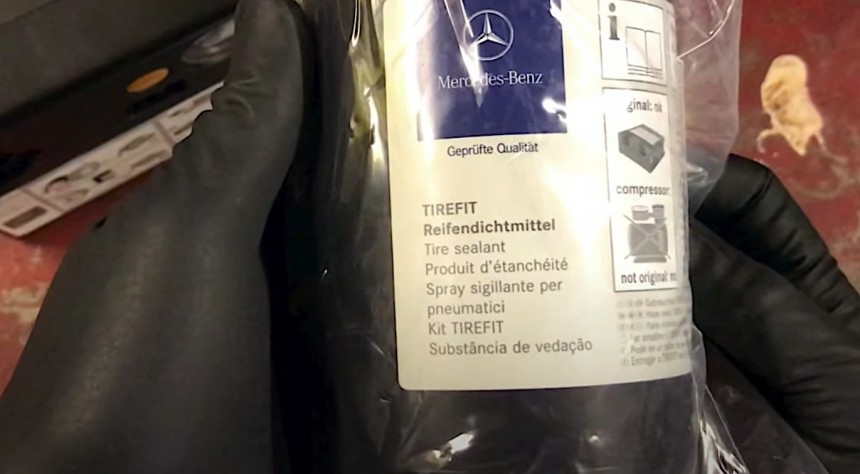If there is one thing in this world we drivers hate the most about a car, it is that any vehicle, regardless of the brand, is subject to a flat. Whether it is a Mercedes-Benz, a Rolls-Royce, or the East-European wonder Dacia Logan, it seems there is no cure for this plague. One hundred years plus of motoring have gone by and we are still in the dark, as we struggle to find a permanent solution to the rubber's tendency to get pierced, slashed, or torn apart...
Incurable as flat tires are, solutions have always existed, and they'll probably continue to be around for as long as tires are made of inflated rubber. These solutions come in several shapes and sizes, some messier than others, but all of them temporary. So is the solution we're looking at here, although it will not ask of you to get on your knees, get your hands dirty, or even use a lug wrench.
We've all noticed for a while now the carmakers' tendency to no longer offer a spare tire when they sell a new car, but tire repair kits instead. This trend started a while ago with a handful of companies, especially German. Such an idea was first implemented by Mercedes-Benz, and it was called TIREFIT.
In words we can all understand, a TIREFIT kit is a do-it-yourself flat tire repair tool. It is offered as a series of hardware, meaning an air compressor (either manual or electric) and a chemical tire sealant kept inside a pressurized can that is equipped with an extension tube. The two components are not to be used together, but in sequence. As said, TIREFIT will not magically fix a flat forever, but will patch things up a bit until you can get to a place properly equipped to handle the issue.
The pressurized can's extension tube allows the sealant to be introduced inside the tire, where it goes on to find the puncture, covering the interior of the tire. Once that is taken care of, the second step is to use the air compressor to pump the air back in.
The first necessary thing in order to use TIREFIT is, obviously, a flat. Once you are past this point and have gotten over the cursing and swearing, it is time to get a hold of the kit and put it to work.
The first thing you need to do is remove the object that caused the flat in the first place, if you can still find it in there. Once that is out of the way, remove the tire valve's cap - beware, doing so might cause the tire to deflate some more, but don't panic, that's what the compressor is for.
Just as you would do with an air pump or compressor hose, place the extension tube on the can on the now exposed tire valve. When you press the can's nozzle, magic sealant is pumped into the tire chamber to fix any problems. Keep in mind, it's very important for you to empty the entire can into the tire to make sure things work as advertised. Be careful not to throw the can away, as this is an environmental no-no, so hold on to it until you find a proper place to dispose of it.
And now comes the time to use the compressor. Connect the thing's hose to the tire valve to begin inflating the wheel. Pumping air into the tire ensures the previously distributed sealant is pushed against the inside of the tire and fills in all holes. Since this is not superglue we're dealing with, there's no need to apply pressure or wait for it to set. That pretty much means once the wheel is inflated, you're good to go.
You should be careful, though, especially during the first few miles traveled with such a patched-up tire. Try not to exceed 19 mph (30 kph), or the spinning motion will send sealant flying all around and away from the damaged sections. After a few miles, you could go as fast as 50 mph (80 kph), but under no circumstance are you to floor it. After all, you're still running a flat.
The sealant can only get you so far and you should look to get the tire professionally fixed as soon as possible. Although there are some recommended distances you can cover this way, there is no conclusive data on how far it's possible to get like this before the sealant is no longer effective. That's because the distance may vary depending on a variety of factors, including road surface, potholes, or gradient.
You'll eventually need to get specialized help, with people actually taking the damaged wheel off and replacing the tire.
Aside from allowing you to travel with a flat, another bright side of TireFit is that it's small, compact, and uses about as much space as a shaving kit would. You don't have to get your hands dirty to fix the problem, you don't have to twist your body in an unnatural way, and you're done almost in no time at all. The tech is perfect for covering up small punctures in the tire and it does not involve asking all the car's occupants to step out of the car so you can jack it up.
On the downside, this solution remains a temporary one. It doesn't solve the problem, but only makes it go away for a short time. Then, the sealant can is a single-use deal, and you'll need to replace it after each flat. Replacing a can (available at most gas stations and roadside stores) will cost you more than fixing the problem the hard way.
Then there's the problem of larger punctures. For the sealant to have the advertised effect, the hole in your tire needs to comply with some size and shape requirements, but punctures being what they are, they rarely do. TIREFIT becomes less effective when applied to cover a larger hole.
In addition, having no spare wheel whatsoever will only make things worse if the flat is not caused by a puncture, but by damage to the rim.
To put an end to it, it is time to say we find TIREFIT not to be as useful as it may first appear to be. But, as the saying goes, beauty is in the eye of the beholder. So is usefulness, and given how such devices have a tendency to completely replace spares these days, we'll have to get used to them.
We've all noticed for a while now the carmakers' tendency to no longer offer a spare tire when they sell a new car, but tire repair kits instead. This trend started a while ago with a handful of companies, especially German. Such an idea was first implemented by Mercedes-Benz, and it was called TIREFIT.
In words we can all understand, a TIREFIT kit is a do-it-yourself flat tire repair tool. It is offered as a series of hardware, meaning an air compressor (either manual or electric) and a chemical tire sealant kept inside a pressurized can that is equipped with an extension tube. The two components are not to be used together, but in sequence. As said, TIREFIT will not magically fix a flat forever, but will patch things up a bit until you can get to a place properly equipped to handle the issue.
The pressurized can's extension tube allows the sealant to be introduced inside the tire, where it goes on to find the puncture, covering the interior of the tire. Once that is taken care of, the second step is to use the air compressor to pump the air back in.
The first thing you need to do is remove the object that caused the flat in the first place, if you can still find it in there. Once that is out of the way, remove the tire valve's cap - beware, doing so might cause the tire to deflate some more, but don't panic, that's what the compressor is for.
Just as you would do with an air pump or compressor hose, place the extension tube on the can on the now exposed tire valve. When you press the can's nozzle, magic sealant is pumped into the tire chamber to fix any problems. Keep in mind, it's very important for you to empty the entire can into the tire to make sure things work as advertised. Be careful not to throw the can away, as this is an environmental no-no, so hold on to it until you find a proper place to dispose of it.
And now comes the time to use the compressor. Connect the thing's hose to the tire valve to begin inflating the wheel. Pumping air into the tire ensures the previously distributed sealant is pushed against the inside of the tire and fills in all holes. Since this is not superglue we're dealing with, there's no need to apply pressure or wait for it to set. That pretty much means once the wheel is inflated, you're good to go.
The sealant can only get you so far and you should look to get the tire professionally fixed as soon as possible. Although there are some recommended distances you can cover this way, there is no conclusive data on how far it's possible to get like this before the sealant is no longer effective. That's because the distance may vary depending on a variety of factors, including road surface, potholes, or gradient.
You'll eventually need to get specialized help, with people actually taking the damaged wheel off and replacing the tire.
Aside from allowing you to travel with a flat, another bright side of TireFit is that it's small, compact, and uses about as much space as a shaving kit would. You don't have to get your hands dirty to fix the problem, you don't have to twist your body in an unnatural way, and you're done almost in no time at all. The tech is perfect for covering up small punctures in the tire and it does not involve asking all the car's occupants to step out of the car so you can jack it up.
Then there's the problem of larger punctures. For the sealant to have the advertised effect, the hole in your tire needs to comply with some size and shape requirements, but punctures being what they are, they rarely do. TIREFIT becomes less effective when applied to cover a larger hole.
In addition, having no spare wheel whatsoever will only make things worse if the flat is not caused by a puncture, but by damage to the rim.
To put an end to it, it is time to say we find TIREFIT not to be as useful as it may first appear to be. But, as the saying goes, beauty is in the eye of the beholder. So is usefulness, and given how such devices have a tendency to completely replace spares these days, we'll have to get used to them.











